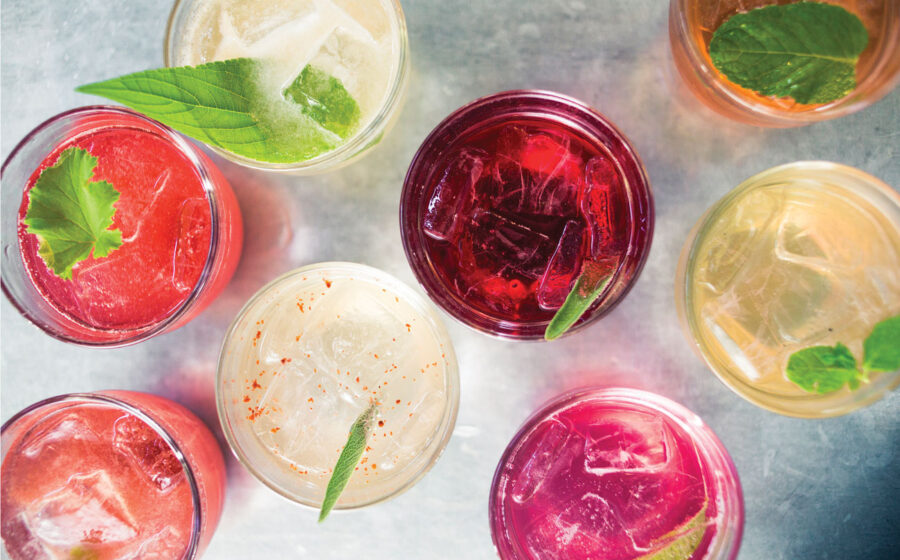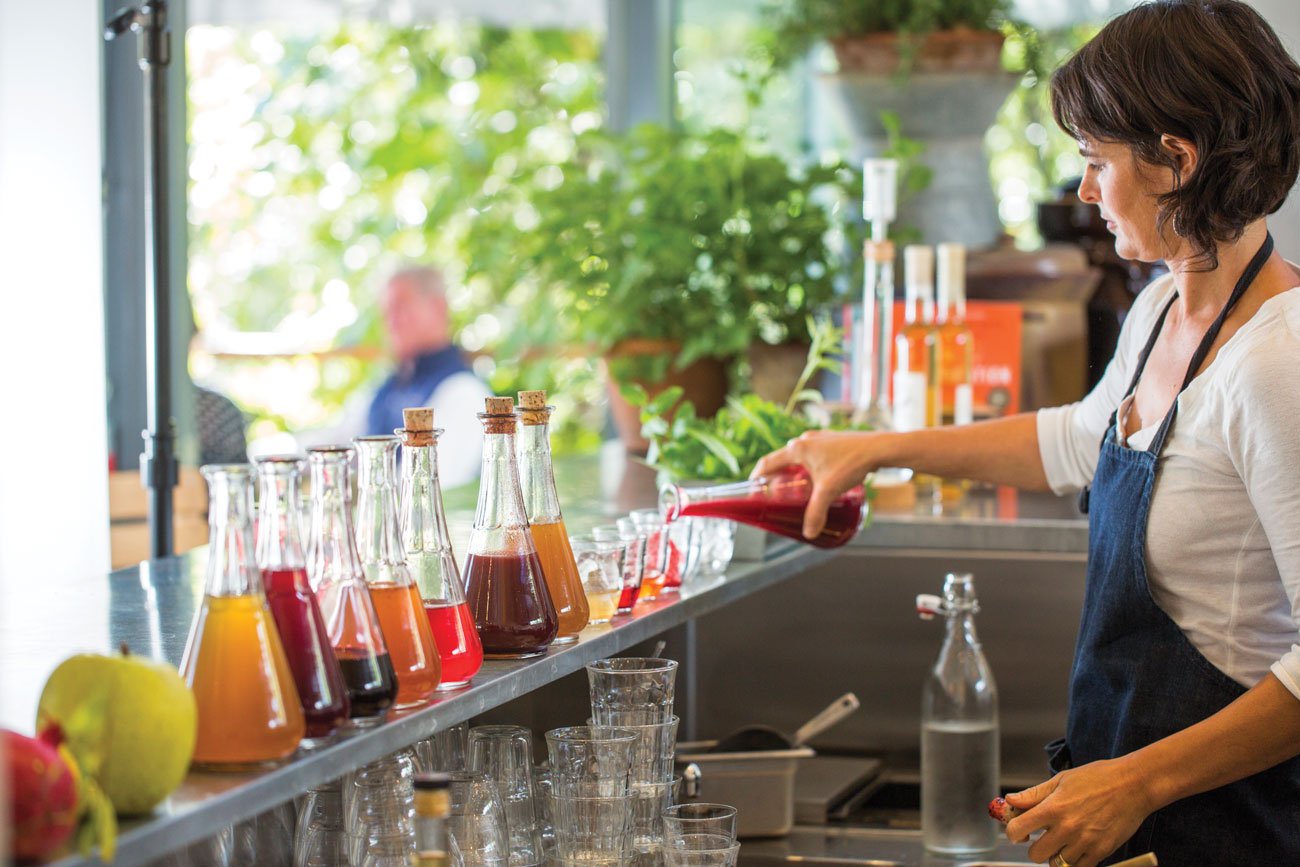I stepped into Shed with coffee on the brain. The enormous creekside building in Healdsburg, California, is a culinary bazaar, an ever-changing marketplace of Sonoma County’s many gustatory offerings.
It is both an old and new stomping ground for me. I know I can get good coffee there, just as I know I will find ardently hopped beers at Bear Republic Brewery across the street and world-class wines at Kendall Jackson’s tasting lounge a few blocks away.
Sonoma County is a cradle of fermentation, thanks to its natural bounty and storied history of winemaking. But since this is also a region of evolving food exploration, there’s always lots to discover. At Shed, you’ll find fine cheese and charcuterie, fresh-baked bread, high-end kitchenware, beekeeping supplies, cocktail toys, locally roasted coffee, and sensory surprises, all converging elegantly in a celebration of excess.
On this particular visit, I rounded out my usual order at Shed’s polished espresso counter by wandering towards the back of the giant space. I walked past the wood-fired pizza and the knife-sharpening counter, where I was excited but not surprised to find what might be the country’s only fermentation bar. There, alongside taps of locally brewed beers, a bartender pours less familiar cultured drinks: house-made herbal kombuchas, fruity kefir waters, and seasonal shrubs.
Sampling a Darjeeling and elderberry kombucha and watching cheerful patrons chat over the brightly colored shrubs, I couldn’t help thinking, this is it. At this moment, for beverages, here we find the central nerve.
Cultures All Around Us
While fermented drinks might represent a cutting edge of beverage culture (they’re primarily DIY, usually hyper-local, cocktail friendly, and supposedly good for the body), they’re still foreign to many. Café culture has only recently begun to embrace kombucha, an ancient cultured tea revered for its health benefits and shied away from by some because of its sourness.
But cultures are all around us: in the bread we eat, the dairy products we buy, and many popular dishes. As palates evolve to embrace more nuanced, deeper flavors, drinks made with an assist from bacteria are being seen in a new light. Fermented beverages present an opportunity for flavor expansion, and they’re quickly taking up their rightful position alongside the flavor powerhouses of coffee and tea.
For some, the idea of a fermented beverage brings to mind drinking vinegar. (In the case of kombucha, which has the same level of acidity, this is not too far off.) But the beverage-curious are finding more than sourness in these drinks, leading them to delve into new realms of fermentation.
Complimenting and Preserving Flavors
There’s a whole world of fermented drinks to explore. Kefir water is a naturally fizzy, subtly sweet cultured water usually flavored with fruit essence. A shrub—a drink fermented with sugar, vinegar, and fruit—made with peak produce can be both tart and explosively flavorful, not unlike a delicious fruit pie. Kombucha, a fermented drink traditionally made with black tea, can take on new flavors when crafted with a quality oolong or green tea.
The stomach-settling qualities of cultured drinks (some are probiotic, similar to yogurt) have already attracted the health-conscious. But its surprising flavors are bringing cultured drinks into the fold of specialty coffee and tea.
In Missoula, Montana, Black Coffee Roasting Company co-owner Jim Chapman is focused first and foremost on good coffee. But when seeking a non-caffeinated, artisanal drink with unique flavors and health benefits, he decided to bring homebrewed shrubs to the menu of his recently opened café.
With flavors like spicy ginger, blackberry lime, and grapefruit, the shrubs—made with seasonal fruits and fermented in apple cider vinegar—have been well received by Black Coffee’s customers. He serves a roster of flavors over ice, mixed with sparkling water, for a fizzy, sweet, and tart elixir that puts soda to shame and draws in non-coffee drinkers in droves.
“I think fermented beverages, especially when made in-house with attention to detail and high-quality ingredients, are an exciting craft that fits perfectly alongside coffee and teas,” says Chapman. “Drinks done well offer an array of flavors and textures and shrubs add to this range.”
Although fermented drinks are gaining popularity in coffee shops, many date back centuries and have practical applications. “Shrubs are the epitome of utilizing a season’s bounty when it’s on its way out,” says Gillian Helquist, food and beverage manager at Shed. “Shrubs are very old beverages that some say are from the turn of the century, but you can find them going way further back in Middle Eastern culture.”
Helquist emphasizes a shrub’s appeal as a rapid form of preservation. Using local produce at the apex of its flavors, she can craft a rotating list of regionally stunning concoctions, like her Sonoma Coast huckleberry and bay leaf shrub or homegrown peach and lemon verbena. Mixing the dense cordial-like fermentation with carbonated water makes a fizzy refresher that allows bright summer flavors to be enjoyed in winter and vice versa.
Combining Coffee and Culture
A few hours south of Shed, Verve Coffee Roasters in Santa Cruz is following fermentation to new heights. With the recent marriage of Verve and local fermented drinks company Dr. Kefir’s, area customers can now enjoy refreshing kefir waters on tap and in bottles at Verve’s cafés and buy coffee- and tea-spiked Dr. Kefir’s at local organic groceries.
Made with dairy-free kefir cultures (which look like tiny crystals and nothing like the amorphous symbiotic culture of bacteria and yeast that breeds kombucha), Dr. Kefir’s tastes less like a sour tea than a lightly fizzy, slightly sweet soda.
“People who don’t like the taste of kombucha really tend to like this,” says Brian Lovejoy, Dr. Kefir’s creator and Verve’s head of ready-to-drink, adding, “the Verve customer is more discerning than your average coffee drinker, so they have an appreciation for crafted beverages. They appreciate the small-batch nature and quality ingredients of this.”
Taking the union to the next level, Brian and the roasters at Verve crafted a kefir drink using Verve’s popular Streetlevel cold-brewed coffee. Usually served on nitro, the toasty, smooth brew becomes bright and clean with the addition of carbonation and the kefir’s tartness.
For coffee lovers, the coffee and kefir drink is a new way to enjoy the subtleties of cold brew. Dr. Kefir’s rooibos flavor, another drink made in the spirit of collaboration and exploring new tastes, is bursting with the tea’s characteristic sweet creaminess. These experiments prove that coffee and tea don’t just coexist well with fermentation—they shine in new ways through it.
Easier Than You Might Think
In Texas, another cold, fermented brew is making waves in the cultured category. Coffer is a fermented, naturally effervescent drink made with coffee, cane sugar, and yeast. Although described as a “coffee soda,” it is incredibly robust and transforms the flavors we typically associate with coffee.
Around Austin, where heat-quelling beverages reign, Coffer is enjoyed as an afternoon pick-me-up, sometimes mixed black-and-tan style with complimentary beers. Seeking a way to naturally carbonate coffee without creating more acidity or losing the drink’s quiet character, Coffer founder Kevin Chen experimented with different types of yeast until he found a recipe that amazed him. “It’s not difficult [to ferment],” he says, “but there is that sweet spot when it comes to experimentation.”
Helquist says the same, encouraging her patrons to try making shrubs and kombuchas themselves (Shed sells fermentation crocks, books, and other resources for aspiring fermenters). “They don’t take much once you have the bacteria,” she says. “It’s like getting a sourdough starter; it keeps regenerating itself so you can share it.”
Cafés looking to add fermented drinks to the menu can do just that by purchasing fermenting agents. However, Helquist recommends self-education on the process before serving anything, and Chen stresses patience in finding a flavor balance that works.
A tap system isn’t necessary but is ideal for keeping things fresh and from over-fermenting, meaning they have produced too much alcohol. Since it’s a relatively new category, unlike brewing or distilling, there are no rules (beyond safety rules, which should lead any experimentation you take on), just lots of room to find what makes sense for your cafe.
But if you’re not ready to take on the task of fermentation, there’s still plenty you can do. Consider hosting local fermenters’ drinks on tap (most cities have a kombucha company these days) or seeking bottled fermented drinks to offer customers on the go.
Though there is a comforting, country life appeal to these homespun drinks, fermented beverages are certainly not the provenance of American beverage makers, and their appeal stretches globally. In Japan, popular fermentation bars offer vinegary beverages made from su, a rice vinegar celebrated for its healing properties. In Russia, kvass, a sour, fermented grain drink, is adored by young and old—and is even making its way to US bottlers.
The growth (bacterial or otherwise) of these drinks is inescapable. Learning to love them might be as easy as finding the right one. So sip, sample, and get cultured.
Article by Regan Crisp. Cover photo by Eric Wolfinger.
This article was originally published on January 5, 2015 and has been updated to meet Fresh Cup’s current editorial standards.



















